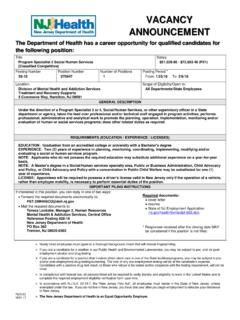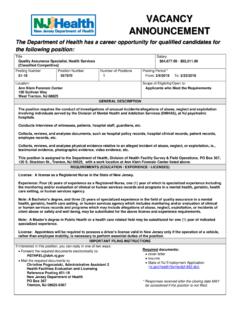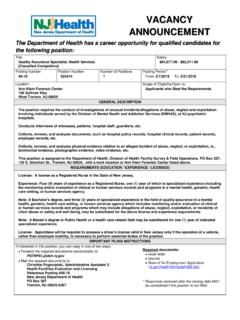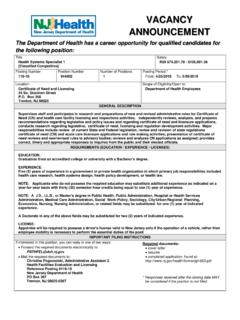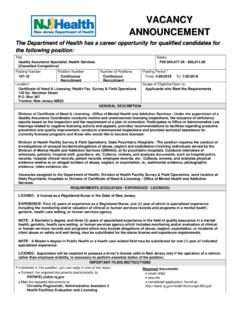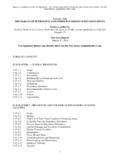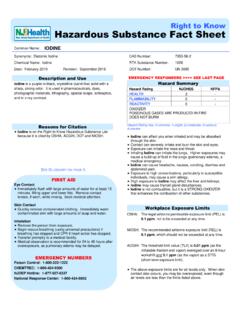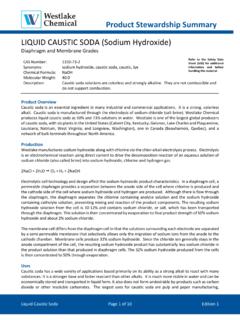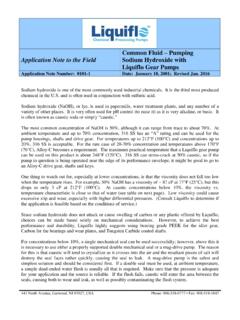Transcription of Right to Know Hazardous Substance Fact Sheet
1 Right to Know Hazardous Substance Fact Sheet Common Name: sodium hydroxide Synonyms: Caustic Soda; Lye; sodium Hydrate Chemical Name: sodium hydroxide Date: April 2010 Revision: November 2015 CAS Number: 1310-73-2 RTK Substance Number: 1706 DOT Number: UN 1823 (solid) UN 1824 (solution) Description and Use sodium hydroxide is an odorless, white solid that absorbs moisture from the air. It is used to make textiles, cellophane, and pulp and paper, in soaps and detergents, and for etching and electroplating. Reasons for Citation sodium hydroxide is on the Right to Know Hazardous Substance List because it is cited by OSHA, ACGIH, DOT, NIOSH, NFPA and EPA. This chemical is on the Special Health Hazard Substance List. SEE GLOSSARY ON PAGE 5. FIRST AID Eye Contact Quickly brush off excess chemical from the face. Immediately flush with large amounts of water for at least 30 minutes, lifting upper and lower lids.
2 Remove contact lenses, if worn, while flushing. Seek medical attention immediately. Skin Contact Quickly remove contaminated clothing. Immediately blot or brush off excess chemical and wash gently with large amounts water for at least 30 minutes. Seek medical attention immediately. Inhalation Remove the person from exposure. Begin rescue breathing (using universal precautions) if breathing has stopped and CPR if heart action has stopped. Transfer promptly to a medical facility. Medical observation is recommended for 24 to 48 hours after overexposure, as pulmonary edema may be delayed. EMERGENCY NUMBERS Poison Control: 1-800-222-1222 CHEMTREC: 1-800-424-9300 NJDEP Hotline: 1-877-927-6337 National Response Center: 1-800-424-8802 EMERGENCY RESPONDERS >>>> SEE LAST PAGE Hazard Summary Hazard Rating NJDHSS NFPA HEALTH - 3 FLAMMABILITY - 0 REACTIVITY - 1 CORROSIVE DO NOT USE WATER Hazard Rating Key: 0=minimal; 1=slight; 2=moderate; 3=serious; 4=severe sodium hydroxide can affect you when inhaled and by passing through the skin.
3 sodium hydroxide is a HIGHLY CORROSIVE CHEMICAL and contact can severely irritate and burn the skin and eyes with possible eye damage. Contact can irritate the mouth, nose and throat. Inhaling sodium hydroxide can irritate the lungs. Higher exposures may cause a build-up of fluid in the lungs (pulmonary edema), a medical emergency. Repeated exposure can lead to permanent lung damage. sodium hydroxide in contact with water or moisture may generate enough heat to ignite combustibles. Workplace Exposure Limits OSHA: The legal airborne permissible exposure limit (PEL) is 2 mg/m3 averaged over an 8-hour workshift. NIOSH: The recommended airborne exposure limit (REL) is 2 mg/m3, which should not be exceeded at any time. ACGIH: The threshold limit value (TLV) is 2 mg/m3, which should not be exceeded at any time. The above exposure limits are for air levels only. When skin contact also occurs, you may be overexposed, even though air levels are less than the limits listed above.
4 sodium hydroxide Page 2 of 6 Determining Your Exposure Read the product manufacturer s Material Safety Data Sheet (MSDS) and the label to determine product ingredients and important safety and health information about the product mixture. For each individual Hazardous ingredient, read the New Jersey Department of Health Hazardous Substance Fact Sheet , available on the RTK website ( ) or in your facility s RTK Central File or Hazard Communication Standard file. You have a Right to this information under the New Jersey Worker and Community Right to Know Act and the Public Employees Occupational Safety and Health (PEOSH) Act if you are a public worker in New Jersey, and under the federal Occupational Safety and Health Act (OSHA) if you are a private worker. The New Jersey Right to Know Act requires most employers to label chemicals in the workplace and requires public employers to provide their employees with information concerning chemical hazards and controls.
5 The federal OSHA Hazard Communication Standard (29 CFR ) and the PEOSH Hazard Communication Standard ( 12:100-7) require employers to provide similar information and training to their employees. This Fact Sheet is a summary of available information regarding the health hazards that may result from exposure. Duration of exposure, concentration of the Substance and other factors will affect your susceptibility to any of the potential effects described below. Health Hazard Information Acute Health Effects The following acute (short-term) health effects may occur immediately or shortly after exposure to sodium hydroxide : Contact can severely irritate and burn the skin and eyes with possible permanent eye damage (corneal opacities), causing blindness. Contact can irritate the mouth, nose and throat. Inhaling sodium hydroxide can irritate the lungs causing coughing and/or shortness of breath. Higher exposures may cause a build-up of fluid in the lungs (pulmonary edema), a medical emergency, with severe shortness of breath.
6 Chronic Health Effects The following chronic (long-term) health effects can occur at some time after exposure to sodium hydroxide and can last for months or years: Cancer Hazard According to the information presently available to the New Jersey Department of Health, sodium hydroxide has not been tested for its ability to cause cancer in animals. Reproductive Hazard There is no evidence that sodium hydroxide affects reproduction. This is based on test results presently available to the NJDH from published studies. Other Effects sodium hydroxide can irritate the lungs. Repeated exposure may cause bronchitis to develop with coughing, phlegm, and/or shortness of breath. Repeated exposure can lead to permanent lung damage. Medical Medical Testing For frequent or potentially high exposure (half the PEL or greater), the following are recommended before beginning work and at regular times after that: Lung function tests If symptoms develop or overexposure is suspected, the following is (are) recommended: Consider chest x-ray after acute overexposure Exam of the eyes and vision Any evaluation should include a careful history of past and present symptoms with an exam.
7 Medical tests that look for damage already done are not a substitute for controlling exposure. Request copies of your medical testing. You have a legal Right to this information under the OSHA Access to Employee Exposure and Medical Records Standard (29 CFR ). Mixed Exposures Smoking can cause heart disease, lung cancer, emphysema, and other respiratory problems. It may worsen respiratory conditions caused by chemical exposure. Even if you have smoked for a long time, stopping now will reduce your risk of developing health problems. sodium hydroxide Page 3 of 6 Workplace Controls and Practices Very toxic chemicals, or those that are reproductive hazards or sensitizers, require expert advice on control measures if a less toxic chemical cannot be substituted. Control measures include: (1) enclosing chemical processes for severely irritating and corrosive chemicals, (2) using local exhaust ventilation for chemicals that may be harmful with a single exposure, and (3) using general ventilation to control exposures to skin and eye irritants.
8 For further information on workplace controls, consult the NIOSH document on Control Banding at The following work practices are also recommended: Label process containers. Provide employees with hazard information and training. Monitor airborne chemical concentrations. Use engineering controls if concentrations exceed recommended exposure levels. Provide eye wash fountains and emergency showers. Wash or shower if skin comes in contact with a Hazardous material. Always wash at the end of the workshift. Change into clean clothing if clothing becomes contaminated. Do not take contaminated clothing home. Get special training to wash contaminated clothing. Do not eat, smoke, or drink in areas where chemicals are being handled, processed or stored. Wash hands carefully before eating, smoking, drinking, applying cosmetics or using the toilet. In addition, the following may be useful or required: Use a vacuum to reduce dust during clean-up.
9 DO NOT DRY SWEEP. Personal Protective Equipment The OSHA Personal Protective Equipment Standard (29 CFR ) requires employers to determine the appropriate personal protective equipment for each hazard and to train employees on how and when to use protective equipment. The following recommendations are only guidelines and may not apply to every situation. Gloves and Clothing Avoid skin contact with sodium hydroxide . Wear personal protective equipment made from material which can not be permeated or degraded by this Substance . Safety equipment suppliers and manufacturers can provide recommendations on the most protective glove and clothing material for your operation. Safety equipment manufacturers recommend Butyl, Nitrile, Neoprene, Polyvinyl Chloride, Silver Shield /4H , Viton and Barrier as glove materials for sodium hydroxide in solution, and Tychem SL, and Responder , and Trellchem HPS and VPS, or the equivalent, as protective clothing materials for sodium hydroxide solid or solution.
10 All protective clothing (suits, gloves, footwear, headgear) should be clean, available each day, and put on before work. Eye Protection Wear eye protection with side shields or goggles. Wear a face shield along with goggles when working with corrosive, highly irritating or toxic substances. Respiratory Protection Improper use of respirators is dangerous. Respirators should only be used if the employer has implemented a written program that takes into account workplace conditions, requirements for worker training, respirator fit testing, and medical exams, as described in the OSHA Respiratory Protection Standard (29 CFR ). Where the potential exists for exposure over 2 mg/m3, use a NIOSH approved negative pressure, air-purifying, particulate filter respirator with an N, R or P100 filter. More protection is provided by a full facepiece respirator than by a half-mask respirator, and even greater protection is provided by a powered-air purifying respirator.

